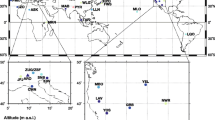Abstract
Travelers have long known that clouds, fog, and cold winds appear in mountainous areas. The shepherds who grazed their flocks in the high mountains in summer also knew very well the difference in climate between the highlands and the lowlands. These differences began to be interpreted using scientific methods only in the eighteenth century.
The famous Russian scientist Lomonosov wrote in 1753 that “there is a difference in density and heating between the air at ground level and at height.” It was clear to him that the upper parts of the atmosphere are less heated by the Sun than the lower, near-surface air. The detailed characteristics of mountainous areas were particularly well studied by the famous Swiss naturalist Saussure (1740–1799). Besides the Alps, he also visited other mountains. In 1772, he climbed Vesuvius and in 1783 Etna. On his mountain tours, he always made numerous meteorological measurements. Thus, on August 3, 1787, Saussure climbed Mont Blanc, the highest peak in Europe (4810 m). Only one man before him climbed that inaccessible snowy peak. He made numerous measurements along the way. Among other things, he discovered that there is a lot of carbon dioxide in the air. He measured that at the top the boiling point of water was 68.993°R. At the same time, his son measured at the foot of Mont Blanc, in Chamonix, and in Geneva, Sennebier. The following year, Saussure spent 17 days (from July 3 to 19) on the Ghent pass (3370 m) near Mont Blanc. He then measured the daily changes in pressure and temperature and noted the difference in the blueness of the sky. He discovered that the change in pressure at altitude is of the opposite sign to the change in ground level. He also found that temperature decreases with height by 1°R per 100 toises (0.65 °C per 100 m).
Others have made similar measurements. Thus, by measuring the Pyrenees in 1802–1804, Raymond calculated that the decrease in temperature with height was 0.49 °C/100 m. The first permanent mountain station was set up on the St. Gotthard Pass (2100 m) within the Mannheim Society. The measurements were made by priests in the hostel belonging to the Capuchin order. When Saussure visited the station in 1783, he found that the barometer was not well placed in relation to the scale, so it was pointing up to two lines higher. The great German naturalist A. Humboldt paid close attention to the climatic characteristics of the mountains during his travels in South America from 1799 to 1804. According to the types of vegetation, he determined the climatic zones of the Andes. Through measurements, he determined that the temperature drops faster with height around the high peaks (Chimborazo, 6310 m) than in the mountain ranges around Quito and Bogotá. Through these measurements along the mountain slopes, the first knowledge about the change of meteorological parameters with height was obtained.
Access this chapter
Tax calculation will be finalised at checkout
Purchases are for personal use only
Similar content being viewed by others
References
Hughes, P. 1981. Francis W. Reichelderfer, part I: Aerologists and air devils. Weatherwise 34: 52–59.
———. 1970. Mythical meteorology. ESSA Magazine.
Laskin, D. 1996. Braving the elements, the stormy history of American weather. Doubleday.
Lewis, J.M. 1995. LeRoy Meisinger, part I: Biographical tribute with an assessment of his contributions to meteorology. Bulletin of the American Meteorological Society 76: 33–45.
Loomis, E. 1841. Meteorological observations made at Hudson. American Journal of Science and Arts, Ohio 40.
Ludlum, D. 1984. The weather factor. Houghton Mifflin.
Molchanov, P. A. 1933. Institut aerologii GGO za pyatnadtsat’let (The Aerological Institute of GGO over Fifteen Years) – Meteor. Vestn., No. 1.
Reichelderfer, F.W. 1928. Postgraduate course in aerology and meteorology for naval officers. Bulletin of the American Meteorological Society 9: 149–151.
Teisserenc De Bort, L., and I.H. Hildebrandsson. 1898–1907. Les bases de la météorologie dynamique, I–VII.
Author information
Authors and Affiliations
Corresponding author
Rights and permissions
Copyright information
© 2023 The Author(s), under exclusive license to Springer Nature Switzerland AG
About this chapter
Cite this chapter
Ćurić, M., Spiridonov, V. (2023). Exploring the Free Atmosphere. In: History of Meteorology. Springer, Cham. https://doi.org/10.1007/978-3-031-45032-7_8
Download citation
DOI: https://doi.org/10.1007/978-3-031-45032-7_8
Published:
Publisher Name: Springer, Cham
Print ISBN: 978-3-031-45031-0
Online ISBN: 978-3-031-45032-7
eBook Packages: Earth and Environmental ScienceEarth and Environmental Science (R0)




